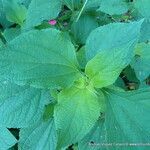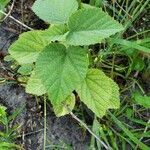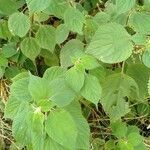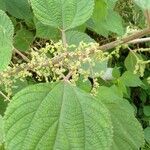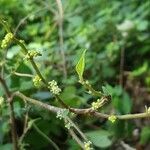Perennial subshrub or shrub to 3 (–7) m high. Leaves alternate; lamina usually broadly ovate, coarsely serrate with teeth (2–) 3–7 mm long at broadest part of leaf and terminal ‘tooth’ of apex forming an acumen, acute to rounded or ± truncate at base, (4–) 6–15 cm long, (3–) 4–10 (–13) cm wide, herbaceous, with main palmate veins somewhat asperous above (the adaxial surface can be glabrous, with sparse coarse cystoliths giving rough feel, or also with sparse fine, adpressed hairs), reticulate below with veins densely pilose, white between the veins (although reported as white by Green (1994) for plants on Norfolk Island, the abaxial surface can be with or without the shining white tomentum of long tangled hairs that can vary in density from thick and obscuring coarser reticulation to thinner and patchy with even fine reticulation visible); petiole (2–) 4–12 cm long. Inflorescence lax, paniculate, 5–10 cm long; flowers clustered. Male flowers 4-merous; perianth lobes c. 1–1.5 mm long, united at base, almost glabrous. Female flowers with pilose, rhomboid-ellipsoidal perianth; style c. 1 mm long.
An erect shrub which grows from year to year. It is 1-3 m tall. The underground roots are thick storage roots. The leaves occur one after another along opposite sides of the stem. The leaves have long leaf stalks and are oval but broad. They have teeth along the edge. They are 7.5-15 cm long by 5-10 cm wide. The leaves are white underneath. The more tropical form does not have hairs under the leaf. The flowers are small. They occur in the axils of leaves. The flowers have separate sexes. The male flowers are lower down and the female flowers higher up. The fruit is a small dry one seeded fruit. It is brownish-yellow and about 1 mm long. Flowers are wind pollinated.
Shrubs or subshrubs , 2(-3) m. Leaves alternate. Leaf blades broadly ovate to nearly orbiculate, 8-15 × 5-12 cm, abaxial surface densely white-tomentose, adaxial surface slightly scabrous. Inflorescences panicles of moniliform (beaded) clusters, branches not leafy at apex; staminate flowers in proximal leaf axils, pistillate flowers in distil axils. Achenes compressed or lenticular, ovoid or ellipsoid, ca. 1.5 × ca. 0.9 mm, pubescent with straight or slightly curved hairs, uniformly smooth; seeds not conspicuous in outline, corky tissue absent.
